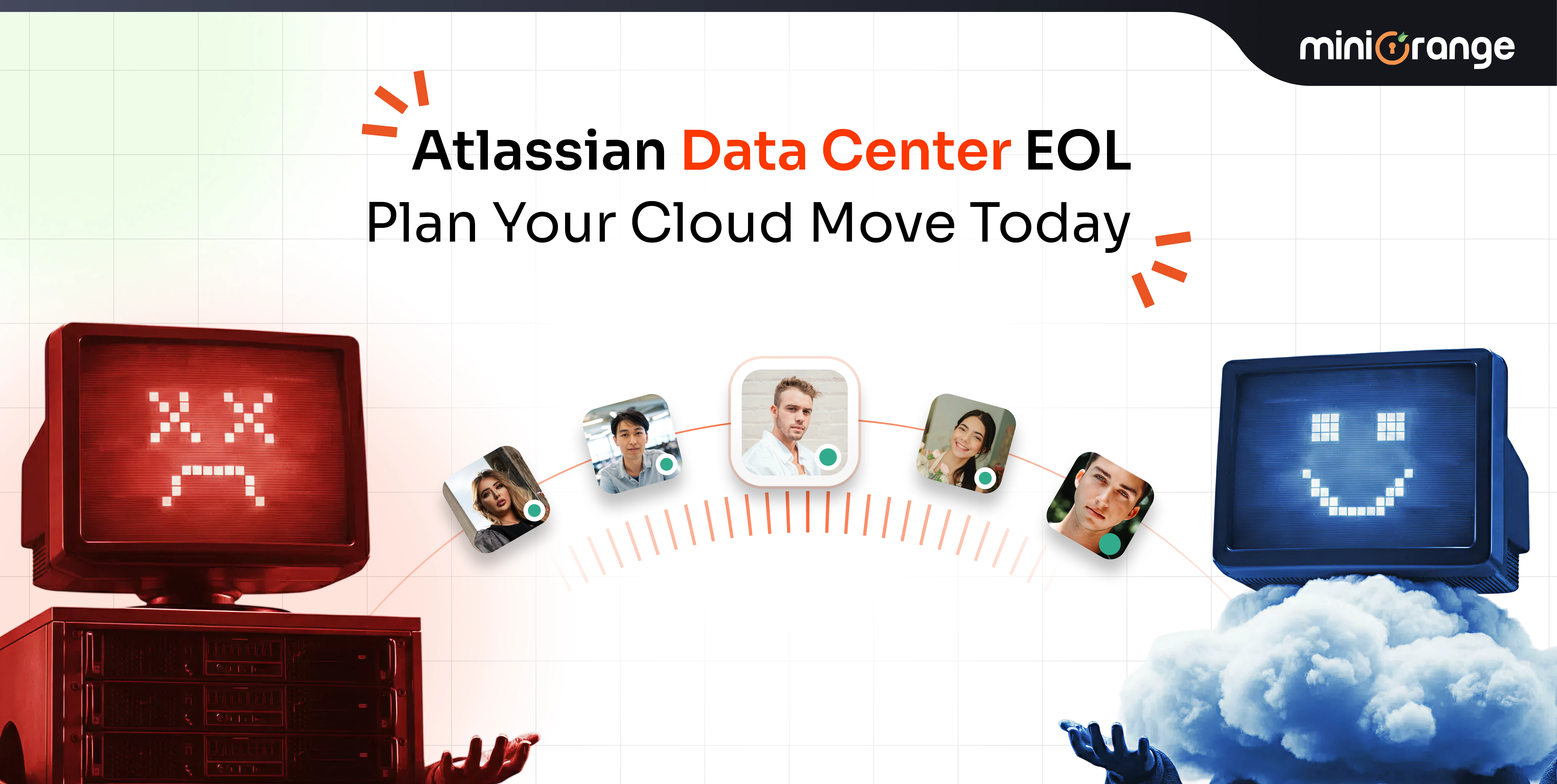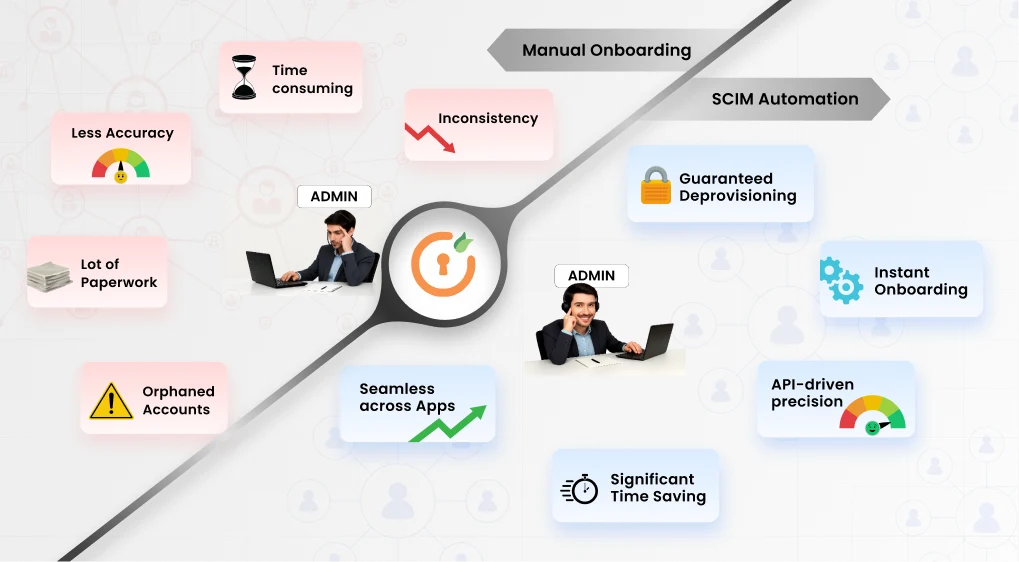Enterprises today rely heavily on Atlassian applications, Jira, Confluence, Bitbucket, and Crowd, for their daily operations. But as teams scale, managing user accounts across these platforms becomes a time-consuming, error-prone task. From onboarding new employees to revoking access when someone leaves, IT admins are often stuck in a cycle of manual updates that drain resources and expose organizations to security risks.
The solution? SCIM (System for Cross-domain Identity Management). SCIM is an open standard that automates provisioning and deprovisioning between your identity provider (IdP), like Okta, Azure AD, OneLogin, or Keycloak, and your Atlassian applications. With miniOrange’s SCIM User Sync, IT admins gain centralized, real-time control of the user lifecycle.
Why Manual User Management Falls Short
- Error-Prone Updates: Role changes require manual edits across multiple apps.
- Security Gaps: Orphaned accounts remain active after departures.
- Scalability Issues: Hundreds or thousands of users quickly overwhelm manual processes.
By contrast, SCIM transforms this into a seamless, automated flow: create, update, or revoke once in the IdP, and changes reflect everywhere in Atlassian instantly.
Key Use Cases for SCIM in Atlassian
1. New Employee Onboarding (User Creation)
Traditionally, IT admins must create accounts for every new hire in Jira, Confluence, and Bitbucket separately. With SCIM, once a user is created in the IdP (say, Okta), miniOrange SCIM automatically provides accounts in all connected Atlassian apps.
- Benefit: Day-one productivity, employees have immediate access to the tools they need.
2. Updating User Information (User Updation)
When user attributes like phone number, email, or job role change, keeping records consistent across applications is tedious. With SCIM, any updates made in the IdP automatically sync to Atlassian apps in real time.
- Benefit: No data silos, fewer errors, always up-to-date records.
3. Revoking User Access (Deprovisioning)
When an employee exits, lingering access is a serious security and compliance risk. SCIM automates instant deactivation of accounts across Jira, Confluence, and other apps once the user is disabled in the IdP.
- Benefit: Stronger security posture and reduced insider threat exposure.
4. Reducing License Costs
Our SCIM solution includes a feature that automatically removes deactivated accounts from licensed groups, helping organizations save on license expenses.
5. Group Mapping (Dynamic Access Management)
SCIM isn’t just about user accounts, it ensures the right level of access through group management.
Group Mapping Options with miniOrange SCIM:
| Method | How It Works | Best For |
|---|---|---|
| Manual Group Mapping | Admins map IdP groups to Atlassian groups manually. | When group names differ (e.g., Dev Users in Okta vs. Software_Dev in Jira). |
| On-the-Fly Group Mapping | Groups with matching names sync automatically; new groups created in Jira if missing. | Large-scale teams with consistent naming conventions (e.g., Marketing in both Okta and Jira). |
- Benefit: Flexible, scalable group assignments aligned with organizational structure.
Beyond the Basics: Extended SCIM Use Cases
- Identity Migration: Move users smoothly from one IdP to another.
- SCIM + SSO Integration: Combine automated provisioning with seamless authentication.
- Attribute Transfer: Extend user attributes to third-party applications for advanced workflows.
Benefits for IT Administrators and Enterprises
SCIM adoption with miniOrange goes far beyond convenience, it directly impacts cost, security, and productivity.
| Feature | Benefit to Admins & Enterprises |
|---|---|
| Automated Provisioning & Deprovisioning | Saves hours of manual effort; reduces licensing costs by removing unused accounts. |
| Granular Access Control | Ensures employees only access what they need, improving security. |
| Real-Time Synchronization | Eliminates delays; changes are reflected instantly across apps. |
| Audit Logs & Compliance | Full visibility into provisioning events to meet compliance requirements. |
| Hybrid Support (Cloud + Data Center) | Works seamlessly regardless of Atlassian deployment type. |
Impact:
- Enhanced security through timely access revocation.
- Reduced IT workload, enabling admins to focus on strategic initiatives.
- Cost optimization via efficient license usage.
- Improved employee experience with faster onboarding.
How miniOrange SCIM Works in Atlassian
- Connect Your IdP: Link Okta, Azure AD, OneLogin, Keycloak, or any SCIM-compliant provider.
- Map Attributes & Groups: Define roles, permissions, and user attributes.
- Automate Workflows: Let provisioning, updates, and deprovisioning flow automatically.
- Monitor & Audit: Use logs to ensure sync health and compliance.
Common Challenges & How miniOrange Solves Them
- External or Guest Users: Custom mapping for contractors or clients.
- Non-Standard Attributes: Flexible schema support for unique organizational needs.
- Sync Visibility: Comprehensive audit logs and monitoring tools.
Wrapping Up
Manual provisioning is no longer sustainable for enterprises running on Atlassian applications. SCIM enables centralized, secure, and automated user lifecycle management, reducing risk, saving time, and improving productivity.
With miniOrange SCIM for Atlassian, you get:
- Seamless integration with major IdPs.
- Flexible group mapping and provisioning options.
- Hybrid support for Cloud and Data Center.
- Full audit trails for compliance.
Empower your IT team to focus on what matters most while ensuring users always have the right access, at the right time.
FAQs
Q1. Can SCIM sync changes in user attributes like phone numbers or roles?
Yes. Any update in your Identity Provider (e.g., Okta, Azure AD) is automatically reflected in Atlassian apps through miniOrange SCIM.
Q2. What happens when an employee leaves the company?
Once the account is deactivated in your IdP, miniOrange SCIM automatically disables or removes the user in Jira, Confluence, or Bitbucket, ensuring security compliance.
Q3. How does group mapping work in miniOrange SCIM?
You can configure manual group mapping (when IdP and Jira group names differ) or on-the-fly mapping (when names match). This ensures users are always in the right groups.
Q4. Does SCIM help with license cost optimization?
Yes. By automatically deprovisioning inactive users, SCIM helps free up licenses in Atlassian apps, reducing unnecessary costs.
Q5. Is SCIM compatible with SSO?
Yes. miniOrange SCIM works alongside SSO. While SSO handles authentication, SCIM manages automatic provisioning and deprovisioning.




Leave a Comment